Hubble’s corrective lens
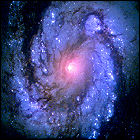 Following the Space Shuttle repair mission to the Hubble Space Telescope, the orbiting telescope’s new Wide Field and Planetary Camera 2 shows incredible improvement in image resolution. By determining the exact deformation of the telescope’s main mirror, the new camera is created almost like corrective glasses: it’s designed to compensate for that deformation at all times. The resulting improvement in image quality is remarkable, enabling Hubble to spot volcanic activity on Io, a moon of Jupiter whose volcanoes have only been visible from space probes making a close flyby. Hubble’s improved vision also arrives just in time to witness an unprecedented event: a cometary collision with Jupiter later in 1994.
Following the Space Shuttle repair mission to the Hubble Space Telescope, the orbiting telescope’s new Wide Field and Planetary Camera 2 shows incredible improvement in image resolution. By determining the exact deformation of the telescope’s main mirror, the new camera is created almost like corrective glasses: it’s designed to compensate for that deformation at all times. The resulting improvement in image quality is remarkable, enabling Hubble to spot volcanic activity on Io, a moon of Jupiter whose volcanoes have only been visible from space probes making a close flyby. Hubble’s improved vision also arrives just in time to witness an unprecedented event: a cometary collision with Jupiter later in 1994.

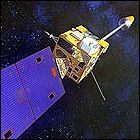 NOAA’s GOES-8 Geostationary Operational Environmental Satellite is launched from Cape Canaveral into a geosynchronous orbit now designated GOES-EAST to monitor weather patterns over the United States; its predecessor, GOES-7, takes up the GOES-WEST position. GOES-8 is a major design evolution in the GOES weather satellite series, incorporating new hardware, some of which proves to be less sturdy than is required for an extensive orbital tour of duty. GOES-8 will remain in the GOES-EAST orbit until it is retired from active weather-watching duty in 2003 and shut down in 2004.
NOAA’s GOES-8 Geostationary Operational Environmental Satellite is launched from Cape Canaveral into a geosynchronous orbit now designated GOES-EAST to monitor weather patterns over the United States; its predecessor, GOES-7, takes up the GOES-WEST position. GOES-8 is a major design evolution in the GOES weather satellite series, incorporating new hardware, some of which proves to be less sturdy than is required for an extensive orbital tour of duty. GOES-8 will remain in the GOES-EAST orbit until it is retired from active weather-watching duty in 2003 and shut down in 2004.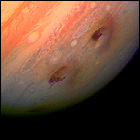 Its collision with the solar system’s largest planet predicted over a year in advance, the fragments of Comet Shoemaker-Levy 9 begin impacting Jupiter’s atmosphere in an astronomical event lasting six days. With Earth-based telescopes watching, as well as cameras and instruments on the Hubble Space Telescope, Galileo and even Voyager 2, huge explosions are witnessed as the cometary chunks slam into Jupiter’s southern hemisphere at over 200,000 miles per hour, leaving dark “scars” larger than the diameter of Earth visible on the planet’s atmosphere and releasing more heat than the surface of the sun. Galileo is still over a year away from arriving at Jupiter.
Its collision with the solar system’s largest planet predicted over a year in advance, the fragments of Comet Shoemaker-Levy 9 begin impacting Jupiter’s atmosphere in an astronomical event lasting six days. With Earth-based telescopes watching, as well as cameras and instruments on the Hubble Space Telescope, Galileo and even Voyager 2, huge explosions are witnessed as the cometary chunks slam into Jupiter’s southern hemisphere at over 200,000 miles per hour, leaving dark “scars” larger than the diameter of Earth visible on the planet’s atmosphere and releasing more heat than the surface of the sun. Galileo is still over a year away from arriving at Jupiter.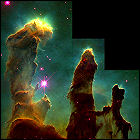 The Hubble Space Telescope, observing M16 (also known as the Eagle Nebula), takes what may be its most famous image: towering clouds of rapidly-evaporating interstellar gas which scientists theorize are the birthplace of new stars. The huge, light-years-long hydrogen clouds are dubbed evaporating gaseous globules, or EGGs; astronomers also call the structure a stellar nursery. The image quickly becomes a mainstay of the media, making appearances in Babylon 5 and the movie Contact.
The Hubble Space Telescope, observing M16 (also known as the Eagle Nebula), takes what may be its most famous image: towering clouds of rapidly-evaporating interstellar gas which scientists theorize are the birthplace of new stars. The huge, light-years-long hydrogen clouds are dubbed evaporating gaseous globules, or EGGs; astronomers also call the structure a stellar nursery. The image quickly becomes a mainstay of the media, making appearances in Babylon 5 and the movie Contact.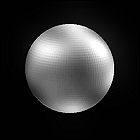 After decades of the tiny object being seen only as a point of light in even the best telescopic images, the Hubble Space Telescope makes the first survey of the surface of Pluto. Even without the distortion introduced by Earth’s atmosphere, Hubble’s best shots of Pluto are vague due to the distance from Earth to Pluto, but they mark the first time that even blurry surface detail has been seen. The new images help NASA gain support for a Pluto flyby mission in the 21st century, which will eventually be named New Horizons.
After decades of the tiny object being seen only as a point of light in even the best telescopic images, the Hubble Space Telescope makes the first survey of the surface of Pluto. Even without the distortion introduced by Earth’s atmosphere, Hubble’s best shots of Pluto are vague due to the distance from Earth to Pluto, but they mark the first time that even blurry surface detail has been seen. The new images help NASA gain support for a Pluto flyby mission in the 21st century, which will eventually be named New Horizons.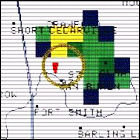 A small but powerful tornado touches down near theLogBook.com’s home office in downtown Fort Smith, Arkansas shortly after 11pm. It traverses two more counties, and kills three people, before dissipating. This is part of a larger tornado outbreak that has plagued much of Oklahoma earlier in the day. The storm is later judged to be an F3 tornado.
A small but powerful tornado touches down near theLogBook.com’s home office in downtown Fort Smith, Arkansas shortly after 11pm. It traverses two more counties, and kills three people, before dissipating. This is part of a larger tornado outbreak that has plagued much of Oklahoma earlier in the day. The storm is later judged to be an F3 tornado.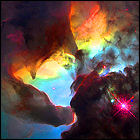 NASA’s Hubble Space Telescope does some interstellar storm spotting, capturing an image of funnel-cloud-shaped structures in the Lagoon Nebula, 5,000 light years away from Earth. Similar to the star-forming structures in the Eagle Nebula, the Lagoon Nebula’s star-birthing clouds are seen to be twisting into tornado-like shapes, possibly due to interactions of gases with extreme hot and cold temperatures, not unlike the weather processes leading to tornado formation on Earth.
NASA’s Hubble Space Telescope does some interstellar storm spotting, capturing an image of funnel-cloud-shaped structures in the Lagoon Nebula, 5,000 light years away from Earth. Similar to the star-forming structures in the Eagle Nebula, the Lagoon Nebula’s star-birthing clouds are seen to be twisting into tornado-like shapes, possibly due to interactions of gases with extreme hot and cold temperatures, not unlike the weather processes leading to tornado formation on Earth.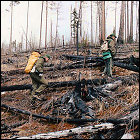 An object from space, possibly as much as 300 feet in diameter, explodes in mid-air at night over the mountainous region near Bodaybo, a village in Irkutsk, Siberia, showering the land below with its fragments and destroying nearly 40 square miles of forest. Neither debris nor the actual “impact” site of the airborne explosion are discovered until 2003, when an expedition discovers the destroyed forest land, comparing the sight to the infamous 1908 Tunguska impact zone. Traces of tritium and slightly radioactive cesium and cobalt are discovered surrounding the impact area, possibly indicating a comet nucleus that broke up in Earth’s atmosphere. Despite the size of the object, it was not detected before its near-impact with Earth.
An object from space, possibly as much as 300 feet in diameter, explodes in mid-air at night over the mountainous region near Bodaybo, a village in Irkutsk, Siberia, showering the land below with its fragments and destroying nearly 40 square miles of forest. Neither debris nor the actual “impact” site of the airborne explosion are discovered until 2003, when an expedition discovers the destroyed forest land, comparing the sight to the infamous 1908 Tunguska impact zone. Traces of tritium and slightly radioactive cesium and cobalt are discovered surrounding the impact area, possibly indicating a comet nucleus that broke up in Earth’s atmosphere. Despite the size of the object, it was not detected before its near-impact with Earth.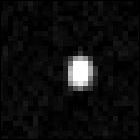 NASA’s Hubble Space Telescope spots an object beyond the orbit of Pluto, and approximately half the size of Pluto – the largest object discovered in the solar system in over 70 years. With a circular orbit that’s a billion miles further from the sun than Pluto, the body is determined to be approximately 800 miles in diameter. Quaoar is believed to be the largest Kuiper Belt object discovered to date, though its thunder will be stolen a few years later with the discovery of Eris and the demotion of Pluto to a dwarf planet.
NASA’s Hubble Space Telescope spots an object beyond the orbit of Pluto, and approximately half the size of Pluto – the largest object discovered in the solar system in over 70 years. With a circular orbit that’s a billion miles further from the sun than Pluto, the body is determined to be approximately 800 miles in diameter. Quaoar is believed to be the largest Kuiper Belt object discovered to date, though its thunder will be stolen a few years later with the discovery of Eris and the demotion of Pluto to a dwarf planet.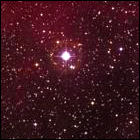 NASA’s Hubble Space Telescope makes an astonishing discovery while observing one of the first planets discovered beyond Earth’s solar system. The gas giant planet designated HD 209458b, orbiting the star HD 209458 in the constellation of Pegasus, 150 light years from Earth, is losing its atmosphere. Slightly larger than Jupiter, but locked into a dizzyingly tight orbit around its star (only 4,000,000 miles, with its “year” lasting less than half of an Earth week), HD 209458b’s atmosphere is boiling away into space thanks to the heat of the nearby star. This leads to a new exoplanet classification, “Hot Jupiters,” used to describe gas giants in similarly suicidal orbits. The core of HD 209458b will probably not last long once the last remnants of its atmosphere dissipate.
NASA’s Hubble Space Telescope makes an astonishing discovery while observing one of the first planets discovered beyond Earth’s solar system. The gas giant planet designated HD 209458b, orbiting the star HD 209458 in the constellation of Pegasus, 150 light years from Earth, is losing its atmosphere. Slightly larger than Jupiter, but locked into a dizzyingly tight orbit around its star (only 4,000,000 miles, with its “year” lasting less than half of an Earth week), HD 209458b’s atmosphere is boiling away into space thanks to the heat of the nearby star. This leads to a new exoplanet classification, “Hot Jupiters,” used to describe gas giants in similarly suicidal orbits. The core of HD 209458b will probably not last long once the last remnants of its atmosphere dissipate.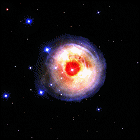 Following up on observations from Earth-based telescopes, NASA’s Hubble Space Telescope is pointed toward the star V838 Monocerotis – an object of very little previous interest – to discover why it’s suddenly the brightest thing in the entire Milky Way Galaxy. What Hubble sees surprises scientists on the ground: a “shell” of matter surrounding the star, illuminated from within and expanding outward into space (actual photo sequence seen here). What astronomers had seen previously was the illumination of the dust cloud, which is much larger than the star itself. Scientists theorize that the expanding dust cloud is not an indication of a supernova, but a sign that V838 Monocerotis is expanding, expelling gas and then shrinking again. The star is over 20,000 light years from Earth.
Following up on observations from Earth-based telescopes, NASA’s Hubble Space Telescope is pointed toward the star V838 Monocerotis – an object of very little previous interest – to discover why it’s suddenly the brightest thing in the entire Milky Way Galaxy. What Hubble sees surprises scientists on the ground: a “shell” of matter surrounding the star, illuminated from within and expanding outward into space (actual photo sequence seen here). What astronomers had seen previously was the illumination of the dust cloud, which is much larger than the star itself. Scientists theorize that the expanding dust cloud is not an indication of a supernova, but a sign that V838 Monocerotis is expanding, expelling gas and then shrinking again. The star is over 20,000 light years from Earth.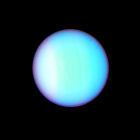 Astronomers using the Hubble Space Telescope discover two new moons of Uranus that eluded detection during Voyager 2’s 1986 flyby: Cupid and Mab. Both small, dark bodies that orbit closer to Uranus than any of the planet’s large satellites, Cupid and Mab raise the number of known Uranian satellites above 20. Mab’s orbit keeps it within the planet’s outermost ring, while Cupid’s orbit is only 500 miles further out than that of Belinda, one of the small moons discovered in 1986 by Voyager 2. Cupid is the tiniest of the inner moons of Uranus, roughly 11 miles in diameter.
Astronomers using the Hubble Space Telescope discover two new moons of Uranus that eluded detection during Voyager 2’s 1986 flyby: Cupid and Mab. Both small, dark bodies that orbit closer to Uranus than any of the planet’s large satellites, Cupid and Mab raise the number of known Uranian satellites above 20. Mab’s orbit keeps it within the planet’s outermost ring, while Cupid’s orbit is only 500 miles further out than that of Belinda, one of the small moons discovered in 1986 by Voyager 2. Cupid is the tiniest of the inner moons of Uranus, roughly 11 miles in diameter.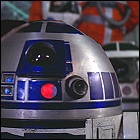
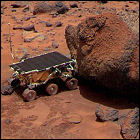 The first four inductees – two real and two fictional – are inducted into the Robot Hall Of Fame created by Carnegie Mellon University’s School of Computer Science.
The first four inductees – two real and two fictional – are inducted into the Robot Hall Of Fame created by Carnegie Mellon University’s School of Computer Science.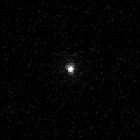 Astronomers using NASA’s Spitzer Space Telescope announce the discovery a tiny planet, with a diameter of only 2,000 kilometers, orbiting the sun three billion kilometers past Pluto. That places it at an average ten billion kilometers away from Earth – with a solar year that lasts around 10,000 years. Sedna is also spotted from ground-based telescopes as well, using the initial observations made by the Spitzer Telescope; its diameter, only 300 kilometers less than that of Pluto, intensifies the “Pluto as a planet” debate that has been raging since the discovery of Quaoar.
Astronomers using NASA’s Spitzer Space Telescope announce the discovery a tiny planet, with a diameter of only 2,000 kilometers, orbiting the sun three billion kilometers past Pluto. That places it at an average ten billion kilometers away from Earth – with a solar year that lasts around 10,000 years. Sedna is also spotted from ground-based telescopes as well, using the initial observations made by the Spitzer Telescope; its diameter, only 300 kilometers less than that of Pluto, intensifies the “Pluto as a planet” debate that has been raging since the discovery of Quaoar.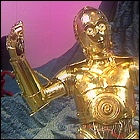
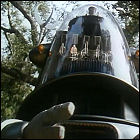 Carnie Mellon University inducts five new members to its Robot Hall Of Fame at a press event promoting the movie adaptation of Isaac Asimov’s I, Robot. The 2004 inductees, again split almost evenly between fictional and real robots, are:
Carnie Mellon University inducts five new members to its Robot Hall Of Fame at a press event promoting the movie adaptation of Isaac Asimov’s I, Robot. The 2004 inductees, again split almost evenly between fictional and real robots, are: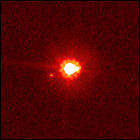 Astronomers at Palomar Observatory discover a body beyond Neptune’s orbit that initial observations show is larger than Pluto. Eris is quickly dubbed the tenth planet by the media and the scientific community, and it is later found to have a small moon of its own in a close orbit, which is later named Dysnomia. But events overtake Eris and Dysnomia before the science textbooks have a chance to be rewritten to include a tenth planet: Eris becomes a case study in an ongoing debate within the International Astronomical Union about the definition of a planet. In 2006, the IAU will establish a set of parameters which determine that Eris isn’t a planet – and then rewrites the history books by deciding that Pluto isn’t either.
Astronomers at Palomar Observatory discover a body beyond Neptune’s orbit that initial observations show is larger than Pluto. Eris is quickly dubbed the tenth planet by the media and the scientific community, and it is later found to have a small moon of its own in a close orbit, which is later named Dysnomia. But events overtake Eris and Dysnomia before the science textbooks have a chance to be rewritten to include a tenth planet: Eris becomes a case study in an ongoing debate within the International Astronomical Union about the definition of a planet. In 2006, the IAU will establish a set of parameters which determine that Eris isn’t a planet – and then rewrites the history books by deciding that Pluto isn’t either. NOAA’s GOES-13 Geostationary Operational Environmental Satellite is launched from Cape Canaveral into geosynchronous orbit to monitor weather patterns over the United States. It will be held in reserve until 2010, when it will be moved to the GOES-EAST position to replace GOES-12, which is suffering chronic attitude control thruster glitches. GOES-13 is yet another evolutionary step up in the GOES satellite hardware, but it will suffer its own share of hardware issues, including a series of inexplicable faults which will cause brief losses of weather coverage, and a later fault which disables infrared imaging capability. Some of these hardware failures will be attributed to micrometeoroid collisions.
NOAA’s GOES-13 Geostationary Operational Environmental Satellite is launched from Cape Canaveral into geosynchronous orbit to monitor weather patterns over the United States. It will be held in reserve until 2010, when it will be moved to the GOES-EAST position to replace GOES-12, which is suffering chronic attitude control thruster glitches. GOES-13 is yet another evolutionary step up in the GOES satellite hardware, but it will suffer its own share of hardware issues, including a series of inexplicable faults which will cause brief losses of weather coverage, and a later fault which disables infrared imaging capability. Some of these hardware failures will be attributed to micrometeoroid collisions.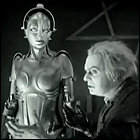 Five new robots, both fictional and real, are inducted into Carnegie Mellon University’s Robot Hall Of Fame. With C-3PO actor Anthony Daniels presenting the awards, the quintet of new inductees consists of:
Five new robots, both fictional and real, are inducted into Carnegie Mellon University’s Robot Hall Of Fame. With C-3PO actor Anthony Daniels presenting the awards, the quintet of new inductees consists of: Astronomers put the red planet on red alert after predicting 1-in-75 odds for an asteroid to collide with Mars on or near January 30th. The asteroid, discovered in November 2007, is on a trajectory that poses no threat to Earth but has better-than-usual odds of packing quite a wallop for Mars. The impact, if it does happen, could take place on the equator, near the Opportunity rover’s stomping (or, perhaps, roving) grounds, though NASA says it would pose no risk to Opportunity. A crater as large as Arizona’s Meteor Crater could be carved out of the Martian surface by any direct hit that does happen. Scientists prepare to watch the event with keen interest, as this event would be potentially cataclysmic if Earth was in danger, but provides a once-in-a-lifetime opportunity for observation on Mars.
Astronomers put the red planet on red alert after predicting 1-in-75 odds for an asteroid to collide with Mars on or near January 30th. The asteroid, discovered in November 2007, is on a trajectory that poses no threat to Earth but has better-than-usual odds of packing quite a wallop for Mars. The impact, if it does happen, could take place on the equator, near the Opportunity rover’s stomping (or, perhaps, roving) grounds, though NASA says it would pose no risk to Opportunity. A crater as large as Arizona’s Meteor Crater could be carved out of the Martian surface by any direct hit that does happen. Scientists prepare to watch the event with keen interest, as this event would be potentially cataclysmic if Earth was in danger, but provides a once-in-a-lifetime opportunity for observation on Mars.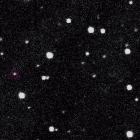 Detected only 20 hours before, the meteoroid designated 2008 TC3 burns up and explodes in Earth’s atmosphere, exploding 23 miles above the Sudanese desert. Estimated to be over ten feet in diameter prior to losing most of its mass to heating in the Earth’s atmosphere, 2008 TC3 is thought to have weighed in at approximately 80 tons; hundred of fragments with a total weight of a little over 20 pounds are recovered from the desert. This is the first Near-Earth Object detected prior to impact or destruction by the NASA-funded Spaceguard survey, though the time between detection, confirmation and arrival is less than a day.
Detected only 20 hours before, the meteoroid designated 2008 TC3 burns up and explodes in Earth’s atmosphere, exploding 23 miles above the Sudanese desert. Estimated to be over ten feet in diameter prior to losing most of its mass to heating in the Earth’s atmosphere, 2008 TC3 is thought to have weighed in at approximately 80 tons; hundred of fragments with a total weight of a little over 20 pounds are recovered from the desert. This is the first Near-Earth Object detected prior to impact or destruction by the NASA-funded Spaceguard survey, though the time between detection, confirmation and arrival is less than a day. NOAA’s GOES-14 Geostationary Operational Environmental Satellite is launched from Cape Canaveral into geosynchronous orbit to monitor weather patterns over the United States. It will be held in reserve until August 2012, when it will be activated to begin monitoring Tropical Storm Isaac as it closes in on the Gulf Coast, and it will redirected to monitor Hurricane Sandy’s approach and landfall on the east coast of the United States. In 2013 it will be moved to a position near the GOES-EAST geostationary position to cover the Atlantic Ocean and the east coast during one of GOES-13’s many technical outages. It remains in orbit on standby.
NOAA’s GOES-14 Geostationary Operational Environmental Satellite is launched from Cape Canaveral into geosynchronous orbit to monitor weather patterns over the United States. It will be held in reserve until August 2012, when it will be activated to begin monitoring Tropical Storm Isaac as it closes in on the Gulf Coast, and it will redirected to monitor Hurricane Sandy’s approach and landfall on the east coast of the United States. In 2013 it will be moved to a position near the GOES-EAST geostationary position to cover the Atlantic Ocean and the east coast during one of GOES-13’s many technical outages. It remains in orbit on standby. NOAA’s GOES-15 Geostationary Operational Environmental Satellite is launched from Cape Canaveral into geosynchronous orbit to monitor weather patterns over the United States. In accordance with NOAA’s policy of having standby weather satellites already in orbit before their predecessors are decommissioned, GOES-15 is held in reserve until late 2011, when it will become the primary GOES-WEST satellite. It remains in orbit on active weather-watching duty.
NOAA’s GOES-15 Geostationary Operational Environmental Satellite is launched from Cape Canaveral into geosynchronous orbit to monitor weather patterns over the United States. In accordance with NOAA’s policy of having standby weather satellites already in orbit before their predecessors are decommissioned, GOES-15 is held in reserve until late 2011, when it will become the primary GOES-WEST satellite. It remains in orbit on active weather-watching duty.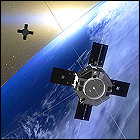 The Radiation Belt Storm Probes mission launched by NASA begins activating sensors just a few days after liftoff, weeks ahead of schedule, just in time to reveal a finding that forces a rethink of over half a century of widely-accepted science. The probes find that, in response to the recent eruption of a solar prominence, the two Van Allen radiation belts discovered in 1958 by Explorer 1 have expanded to include a third belt, which traps and repels additional solar radiation back into space. The third radiation belt dissipates after four weeks, and scientists begin rethinking their theories on Earth’s magnetosphere.
The Radiation Belt Storm Probes mission launched by NASA begins activating sensors just a few days after liftoff, weeks ahead of schedule, just in time to reveal a finding that forces a rethink of over half a century of widely-accepted science. The probes find that, in response to the recent eruption of a solar prominence, the two Van Allen radiation belts discovered in 1958 by Explorer 1 have expanded to include a third belt, which traps and repels additional solar radiation back into space. The third radiation belt dissipates after four weeks, and scientists begin rethinking their theories on Earth’s magnetosphere.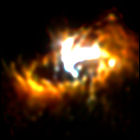 NASA reveals that its Boeing-747-mounted SOFIA (Stratospheric Observatory for Infrared Astronomy) telescope, during a 2011 flight in which its sensitive infrared sensors were aimed at the center of the Milky Way galaxy, captured an image of the super-massive black hole at the heart of the galaxy. A disc of dust and gas circling the center of the galaxy – seven light years across – lights up the image. The black hole is believed to have a mass of over four million times that of Earth’s sun.
NASA reveals that its Boeing-747-mounted SOFIA (Stratospheric Observatory for Infrared Astronomy) telescope, during a 2011 flight in which its sensitive infrared sensors were aimed at the center of the Milky Way galaxy, captured an image of the super-massive black hole at the heart of the galaxy. A disc of dust and gas circling the center of the galaxy – seven light years across – lights up the image. The black hole is believed to have a mass of over four million times that of Earth’s sun. NASA’s Deep Impact probe, already a veteran explorer of comets, turns its camera eye toward Comet ISON, a recently-discovered comet expected to put on a spectacular show even to the naked eye in late 2013. Originally launched in 1995 to study Comet Tempel 1 at close range, Deep Impact has since used its cameras to study other comets passing through the solar system. The distance between Deep Impact and Comet ISON at the time the 36-hour photo sequence is taken is roughly 493 million miles.
NASA’s Deep Impact probe, already a veteran explorer of comets, turns its camera eye toward Comet ISON, a recently-discovered comet expected to put on a spectacular show even to the naked eye in late 2013. Originally launched in 1995 to study Comet Tempel 1 at close range, Deep Impact has since used its cameras to study other comets passing through the solar system. The distance between Deep Impact and Comet ISON at the time the 36-hour photo sequence is taken is roughly 493 million miles.